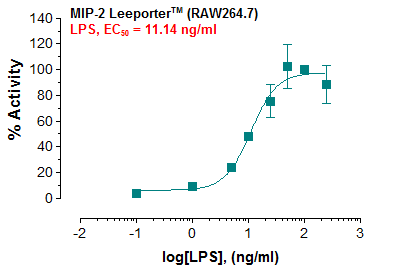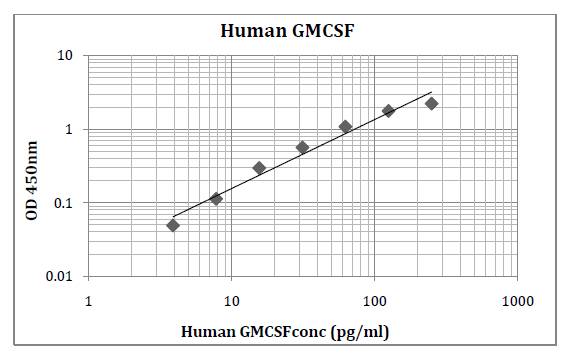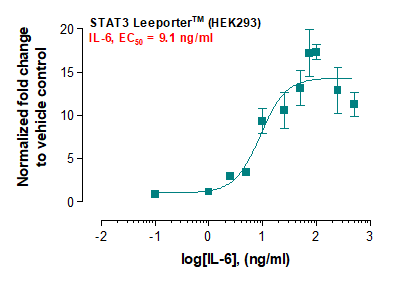Recombinant Human Interleukin-36 gamma/IL-36gamma/IL-1F9
Shipping Info:
For estimated delivery dates, please contact us at [email protected]
| Amount : | 50 µg |
| Content : | Lyophilized from a 0.2 µm filtered solution of 20mM Tris,100mM Nacl,0.1mM EDTA,pH8.0. |
| Storage condition : | Lyophilized protein should be stored at -20°C, though stable at room temperature for 3 weeks. Reconstituted protein solution can be stored at 4-7°C for 2-7 days. Aliquots of reconstituted samples are stable at -20°C for 3 months. |
| AA sequence : | SMCKPITGTINDLNQQVWTLQGQNLVAVPRSDSVTPVTVAVITCKYPEALEQGRGDPIYLGIQNPEMCLYCEKVGEQPTLQLKEQKIMDLYGQPEPVKPFLFYRAKTGRTSTLESVAFPDWFIASSKRDQPIILTSELGKSYNTAFELNIND |
Source: E.coli.
MW :17kD.
Recombinant Human Interleukin-36 gamma is produced by our E.coli expression system and the target gene encoding Ser18-Asp169 is expressed. Interleukin-36 gamma (IL-36 gamma ) is a member of the interleukin 1 cytokine family that includes three closely related genes, IL-36 alpha , beta , and gamma , formerly known as IL-1F6, F8, and F9 respectively. IL-36 alpha has been detected in both neuronal and synovial tissue, whereas IL-36 beta and IL-36 gamma are expressed in both cutaneous and mucosal epithelial cells, including the respiratory tract. IL-36 beta and IL-36 gamma stimulate proliferation, maturation and/or cytokine expression by innate immune cells (such as keratinocytes and dendritic cells), and adaptive immune cells (neutrophils and T-cells) in both humans and mice. The activity of IL-36 alpha is mediated by interleukin 1 receptor-like 2 (IL1RL2/IL1R-rp2), and is specifically inhibited by interleukin 1 family, member 5 (IL1F5/IL-1 delta). IL-36 gamma plays an important role in communicating the cell death to surrounding cells.
MW :17kD.
Recombinant Human Interleukin-36 gamma is produced by our E.coli expression system and the target gene encoding Ser18-Asp169 is expressed. Interleukin-36 gamma (IL-36 gamma ) is a member of the interleukin 1 cytokine family that includes three closely related genes, IL-36 alpha , beta , and gamma , formerly known as IL-1F6, F8, and F9 respectively. IL-36 alpha has been detected in both neuronal and synovial tissue, whereas IL-36 beta and IL-36 gamma are expressed in both cutaneous and mucosal epithelial cells, including the respiratory tract. IL-36 beta and IL-36 gamma stimulate proliferation, maturation and/or cytokine expression by innate immune cells (such as keratinocytes and dendritic cells), and adaptive immune cells (neutrophils and T-cells) in both humans and mice. The activity of IL-36 alpha is mediated by interleukin 1 receptor-like 2 (IL1RL2/IL1R-rp2), and is specifically inhibited by interleukin 1 family, member 5 (IL1F5/IL-1 delta). IL-36 gamma plays an important role in communicating the cell death to surrounding cells.
Endotoxin : Less than 0.1 ng/µg (1 IEU/µg) as determined by LAL test.
For Research Use Only. Not for use in diagnostic/therapeutics procedures.
| Subcellular location: | Secreted |
| Post transnational modification: | N-terminal truncation leads to a dramatic enhancement of its activity (>1000-fold). |
| Tissue Specificity: | Highly expressed in tissues containing epithelial cells: skin, lung, stomach and esophagus. Expressed in bronchial epithelial. In skin is expressed only in keratinocytes but not in fibroblasts, endothelial cells or melanocytes. Up-regulated in lesional psoriasis skin. Expressed in monocyte-derived dendritic cells and M1 macrophages. |
| BioGrid: | 121135. 8 interactions. |
|
There are currently no product reviews
|




















.png)













